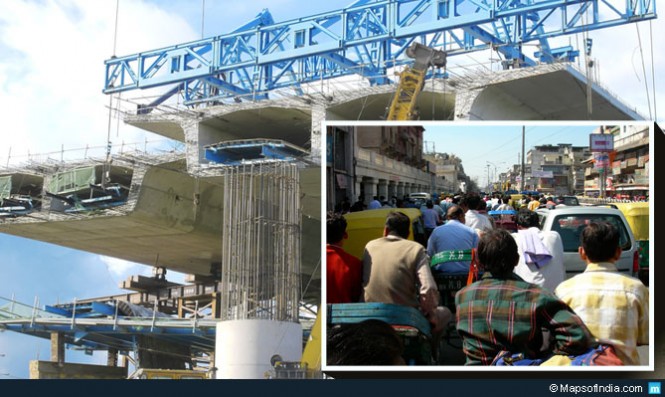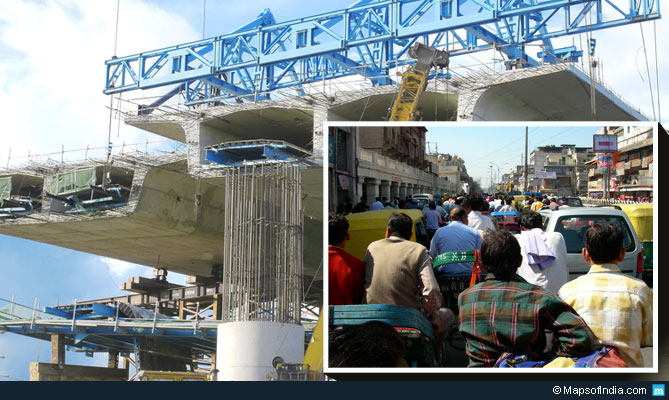 In a span of 30 years, the metro city Delhi has developed to a great extent and today it is considered as one of the most developed cities of the world. One aspect of development is the never-ending construction of flyovers in various areas in Delhi to reduce the problem of traffic congestion and make public transportation more comfortable and easier. In 1982, when Delhi hosted the Asian Games, it had just five flyovers. Presently, Delhi has more than 90 flyovers, and as a matter of fact, the Capital city Delhi can rightly be called as the “city of flyovers”.
In a span of 30 years, the metro city Delhi has developed to a great extent and today it is considered as one of the most developed cities of the world. One aspect of development is the never-ending construction of flyovers in various areas in Delhi to reduce the problem of traffic congestion and make public transportation more comfortable and easier. In 1982, when Delhi hosted the Asian Games, it had just five flyovers. Presently, Delhi has more than 90 flyovers, and as a matter of fact, the Capital city Delhi can rightly be called as the “city of flyovers”.
Repairing of decade-old flyovers
Of the 90 flyovers in the city, 25 were constructed in the last five to six years and they are still in good condition and do not require any repair work. All others are almost a decade old. In a press release by the Public Works Department (PWD) in December 2013, it was stated that all old flyovers in Delhi would be inspected and measures would be taken to repair them with the advice of expert consultants.
Increased load of traffic on these flyovers has led to wear and tear of the expansion joints and bearings on the flyovers which either need to be repaired or changed. PWD officials also said that those flyovers which had been built by other agencies like municipal bodies would also be repaired by the PWD. Some repairing works have already started like in the case of the flyovers at Raja Garden, Defence Colony, Moti Bagh, Ashram, Barapulla, among others. Some have been completed and some are under repair. PWD has also sought permission from the traffic police to carry out the repair works as this would need proper diversion of traffic and closing of one of the passage ways on each flyover.
More flyovers coming up
With the BJP in power, civic agencies are of the opinion that several projects that have been ignored in the past will get priorities now. In fact, PWD has already come up with a list of more than 23 new road and flyover projects in Delhi, the estimated cost of which is over Rs 16,000 crore till 2020. PWD has also planned many other projects for de-congestion of arterial roads and improvement of the Bus Rapid Transit System (BRTS) corridors.
The officials have made a projection of Rs 2,000 crore for the ongoing projects, over the next three years. One such plan includes the parallel flyover at Rao Tula Ram Marg, an underpass at RTR and Barapullah Phase III. In 2019-20, all projects are expected to be completed leaving aside one or two. The construction of a flyover from Kakrola Mor to Wazirabad, along Najafgarh drain, is likely to remain uncompleted. This is also the largest and the most expensive project.
The big question: Aren’t these flyovers a menace to the people?
In pursuit of rapid development, our country has always preferred for quick-fix solutions that might be beneficial for a few in the short-run but end up being problematic for many in the long run. The same applies for urban planning in a city like Delhi or for that matter, any cities in the country.
The basic objective of constructing more and more flyovers is to de-congest the existing traffic. The Government has no doubt given the green signal towards the construction of new flyovers in Delhi. But by the time these are constructed, the number of vehicles as well as the population would have gone up manifold. This is leading to an unending spiral. The increasing number of roads and flyovers had ended up attracting more traffic.
Problems associated with the flyovers/under-construction flyovers in Delhi
- Irrespective of the number of flyovers built, traffic jams are inevitable in Delhi. First of all, the population of Delhi is growing at an alarming rate. The number of vehicles in the city is also growing at an alarming rate, almost 10-15% every year. According to a report by the Centre for Science and Environment, the daily travel trips in Delhi are expected to increase from 15 million at present to 25.3 million in 2020. So, in spite of the fact that Delhi has the most extensive road network in the country, there is not enough space for the traffic.
- According to PWD, in spite of the flyover from Maharani Bagh to South Extension, it often takes 45-50 minutes to cover the distance of 5 km during peak hours. This is the same in most parts of the city.
- While the flyovers at Mayapuri, Rao Tula Ram Marg, Modi Mills, Seelampur, Azadpur, and many others have reduced congestion at one intersection each, these have increased the problem at the next. The reason being, there is a split of the traffic at one section, which merges again at the point where the flyover ends.
- The under-construction flyovers and the flyovers undergoing repair have always obstructed the traffic. For repair work, one lane of the carriageway is always kept blocked, which leads to more traffic jams.
- There is a trend of “induced traffic” phenomenon in Delhi, according to experts. Several major studies have shown that while half of increased flyovers and roadways is used by added traffic, around 80% of the increased capacity is used by induced traffic.
- A latest study by UrbanEmissions.info shows that in most cases, a vehicle on the busy roads of Delhi remain idling or crawling at less than 4 km/hour, which is more than 20% of its running time.
- Last but not the least, the increased growth of flyovers has also been a menace to the pedestrians and the common people on slow-moving transport such as rickshaws by putting them off the roads. Pedestrians have to use either over-ground or under-ground to make way for speeding traffic. And for this, pedestrians have to walk nearly one or two km to reach the nearest underpass to get to the other side. And in some cases, they do not have any option to walk to their destination at major flyovers such as the one at Dhaula Kuan or AIIMS.
Solutions
It is seen in many cities in the Western countries, flyovers and expressways have been dismantled or in the process of being dismantling. Some urban highways in the United States like in Portland, Milwaukee, San Francisco etc. have already been removed. It is not necessary that Delhi will take up such extreme measures. But, there is no doubt that it will be impossible to keep adding to transport and infrastructure in excess of its physical limits very soon.
The Government has to make way for decent travel alternatives and tough measures should be taken for this. Most Delhi commuters have already shifted to using the Metro, the number of daily passengers’ count being almost two million at present. By 2016, another 120 km will be added to its existing network of 190 km by DMRC, which shows an expansion of 63%. Car pooling is another option, which has become popular in recent years. In years to come, the Capital city will also come up with more public transport options in monorail and pod taxis.
Some experts have recommended that the Government should introduce congestion tax and road space rationing in Delhi. Many South American cities do not allow a certain percentage of vehicles to ply on the roads during rush hours every weekday or for the entire day. In London, the congestion charge is applied for commuters between 7 am and 6 pm on weekdays. This has reduced congestion in London and also has helped the Government to raise money for the development of the transport system in the city. All these require political courage as well as co-operation from the general public, to be implemented in Delhi…





